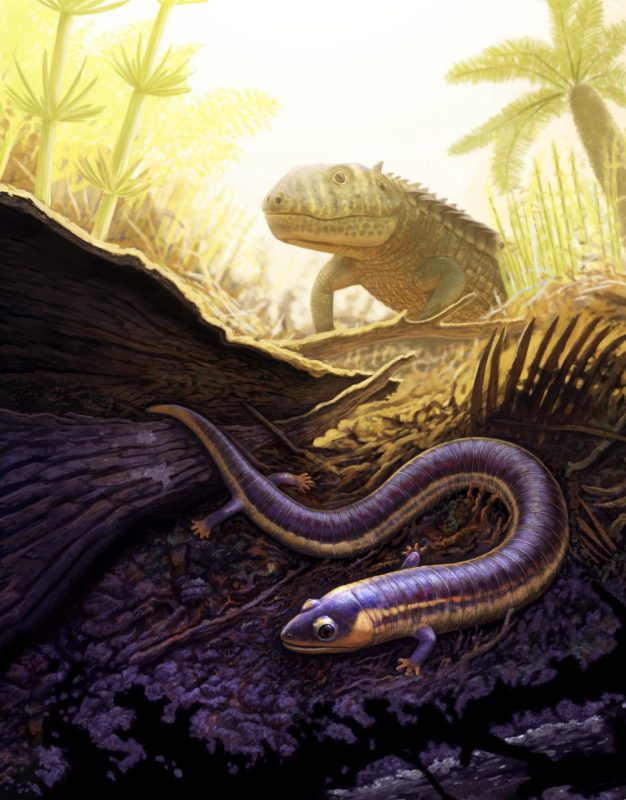
The smallest of newly found fossils can upend what paleontologists know about our history.
A team of paleontologists from Virginia Tech and the U.S. Petrified Forest National Park, among others, have discovered the first “unmistakable” Triassic-era caecilian fossil — the oldest-known caecilian fossils — thus extending the record of this small, burrowing mammal by roughly 35 million years. The find also fills a gap of at least 87 million years in the known historical fossil record of the amphibian-like creature.
The fossil was first co-discovered by Ben Kligman, a doctoral student in the Department of Geosciences, part of the Virginia Tech College of Science, at Arizona’s Petrified Forest National Park during a dig in 2019. Named by Kligman as Funcusvermis gilmorei, the fossil extends the history of caecilians 35 million years back to Triassic Period, roughly 250 million to 200 million years ago.
Prior to this new study, published recently in the journal Nature, only 10 fossil caecilian occurrences were known, dating back to the Early Jurassic Period, about 183 million years ago. However, previous DNA studies estimated evolutionary origins of caecilians back to the Carboniferous or Permian eras, some 370 million to 270 million years ago, according to Kligman, marking that 87-million-year gap. However, no such fossils had been found.
“The discovery of the oldest caecilian fossils highlights the crucial nature of new fossil evidence. Many of the biggest outstanding questions in paleontology and evolution cannot be resolved without fossils like this,” said Kligman, who previously discovered a 220-million-year-old species of cynodont or stem-mammal, a precursor of modern-day mammals.
“Fossil caecilians are extraordinarily rare, and they are found accidentally when paleontologists are searching for the fossils of other more common animals,” said Kligman. “Our discovery of one was totally unexpected, and it transformed the trajectory of my scientific interests.”
The discovery of the fossils was made in 2019 by Kligman and Petrified Forest National Park student intern Xavier Jenkins, now a Ph.D. student at Idaho State University, while the duo was processing fossiliferous sediment from the park’s nicknamed Thunderstorm Ridge via a microscope. Funcusvermis was found in a layer of the Chinle Formation dated to approximately 220 million years ago, when Arizona was positioned near the equator at the central part of the supercontinent Pangaea, Kligman said.
“Seeing the first jaw under the microscope, with its distinctive double row of teeth, sent chills down my back,” Kligman said. “We immediately knew it was a caecilian, the oldest caecilian fossil ever found, and a once-in-a-lifetime discovery.”
Modern caecilians are limbless amphibians with cylindrical bodies with a compact, bullet-shaped skull that helps them burrow underground. Now exclusively home to South and Central America, Africa, and southern Asia, caecilians spend their lives burrowing in leaf-litter or soil searching for prey such as worms and insects. This underground existence has made studying caecilians difficult for scientists. Kligman, tongue in cheek, describes modern caecilians as an “eyeless sock puppet with the body of a worm.”
Now, here’s the fun part: The genus name ‘Funcusvermis’ was inspired by the Ohio Players’ 1972 song “Funky Worm” from their album Pleasure, a favorite song of the authors that was often played while excavating fossils at Thunderstorm Ridge. ‘Funcus’ is derived from the Latinized form of the English word Funky for the upbeat, rhythmic form of dance music, while ‘vermis’ is derived from the Latin word for worm. (It’s an excellent song, by the way. Instant earworm, so to speak.)
“As the eponymous song says, it’s the funkiest worm in the world,” quipped Adam Marsh, the project’s lead paleontologist.
“Since its discovery in 2017, the Thunderstorm Ridge site has produced a diverse assemblage of over 60 animals ranging from freshwater sharks to dinosaurs,” Kligman said. “Several other new species discovered at this site have been recently described. Many other new species from this site are currently under study and will be published in upcoming years.”
In other words, fully expect more upending of what paleontologists know about the history of fossils.




